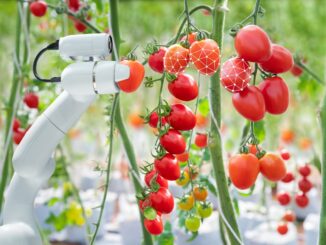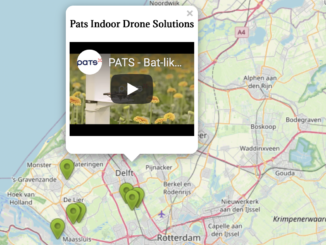This was the title of the September issue of National Geographic. Immediately after that, it stated: “Our work is increasingly being taken over by devices. How is the robot revolution changing our way of life?”. In greenhouse horticulture, robots will also take over some of the work in the greenhouse and packing shed. For many growers, this cannot happen quickly enough. There is a shortage of personnel to pick tomatoes and the lowering and clipping of cucumbers requires a lot of labour.
Still I do not think that replacing this type of work will be the revenue model for the robots that we are currently developing for greenhouse horticulture. Firstly, I don’t feel the need is big enough. In the thirty years that I have been active in horticulture, I can only remember that there was talk about the fact that there were no people to do the work. However, staff was available every time, first from Poland and now increasingly from Eastern Europe. In search of cheaper labour, the work of rooting cuttings and tissue culture repetitively was moved to “a new low-wage country”. Additionally, there are currently hardly any growers who invest in harvesting robots. If we are in urgent need to get these robots working in our greenhouses, I would expect there to be more interest in actively investing. I don’t see that happing, at least not in the Netherlands.
Secondly, the labour that we are now going to replace by robots will probably no longer be relevant in about ten years! The picking robots that we are now developing must work in an environment that was created for humans and for the existing technology and varieties. However, adapting the cultivation system and breeding new varieties is something that cannot be changed just like that in a few years. We will therefore still develop ‘temporary’ solutions for the coming years. Breeders will meanwhile work on varieties that will be easier to harvest by robots and new cultivation systems will be developed. So “Crops for robots” instead of “Robots for crops”.
But if the revenue model does not lie in replacing the current, simple and repetitive work, then where does it?
To find out more about that it is important to look at things that the (harvesting) robot can do much better than humans, namely collecting a lot of data! All that data is a “by-product” of, for example, harvesting cucumbers with a robot. The harvesting robot performs the following actions for each cucumber:
1. Take a picture of the crop.
2. Using image processing, recognize whether cucumbers are visible.
3. Assess whether the cucumber is ready for harvesting.
4. Calculate the distance to the fruit.
5. Determine an obstacle-free route and harvest.
If we look at what is needed for this, we arrive at the following process in simplified form:
A camera is required for the first operation. The images that have been taken are saved and in step two it is determined whether cucumbers are visible in the image. The leaves, plant and cucumbers are all green so a distinction must be made. This can be done, for example, by looking at the reflected light. If a cucumber has been found, it must be determined in step three whether it is ripe. This is done by determining the weight / length of the fruit. When the fruit is ripe for harvesting, step four must determine where the fruit is hanging in the crop. The exact x, y, z position is needed for the robot to properly grasp and harvest the cucumber in step five. If the cucumber is partly hanging behind a leaf, it must be determined from which side the product should be approached. Then the cucumber can be harvested.
Even this simplified description makes it clear that a lot of data is collected during the picking of the cucumber. This data is very valuable and not only necessary to be able to pick the cucumber!
Imagine what you can do if you combine the data of the same plant for different days. You can then follow the development of the plant, determine exactly when it flowers and when the fruit is big enough to harvest. Together with the data from the climate computer, it can be determined exactly what the influence is on the growth rate of the crop and how long it takes before a cucumber is harvestable. This data can also be obtained manually, often a grower will measure and record a few plants in the greenhouse every week in order to keep track of the growth rate. However, these are just a few plants and one measurement per week. What if you could measure each individual plant every day, this gives an even better picture of the growth of the crop! Here we are really talking about BIG data. The results can be used to control the growth more precisely, which in turn will mean that energy and water can be used even more efficiently.
Even more could be learned from the data if the rest of the process is also digitised. There are already sorting robots that can identify damage very precisely with the help of AI. A cucumber is not only rejected, but it is also indicated whether this was the result of, for example, mechanical damage or caterpillar damage. For the person sorting, it can both look the same, especially if the cucumbers quickly pass through the sorting machine. If the sorting robot can already indicate where damage is currently occurring in the greenhouse, adding data from the cultivation process would only provide more possibilities!
By combining the data from the sorting and cultivation process, increasingly better predictions can be made about the quality of the cucumbers. This means that during cultivation it is easier to manage growth and increase shelf life. This results in less waste of products further down the chain.
The above shows that robots in horticulture are about much more than simply replacing labour for which we currently have not enough people. Yes, robots will eventually take over some of the boring, repetitive work of humans. However, the real value will lie in offering opportunities for new business models. Data collected by robots that are already working in the greenhouse, for example to harvest, plays an important role in this!
To answer to the question “How is the robot revolution changing our way of life?” a lot is still unclear but it certain that in the greenhouse horticulture of the (near) future, people and robots (cobots) will be working together more than ever!





Be the first to comment